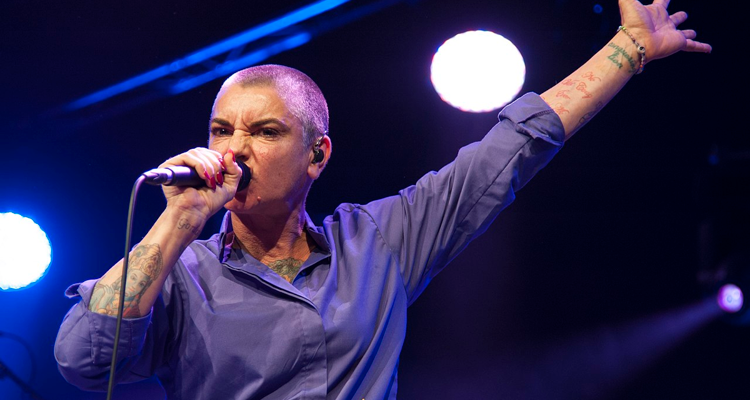
Photo Credit: Bryan Ledgard / CC by 2.0
Sinéad O’Connor never hesitated to speak out about the injustice she saw in the world, which saw the derailing of her career at the height of her fame. But the Irish singer saw things differently.
Most well-known for her haunting vocals on the song “Nothing Compares 2 U,” the accompanying one-take music video featuring her shaved head and crying face, and a shocking performance on Saturday Night Live in 1992, Sinéad O’Connor was a memorable artist in the early ’90s who never strayed from the things she felt were most important.
Her most well-known controversy, many have said that Sinéad’s surprise move at the end of her Saturday Night Live performance in 1992 killed her young career.
O’Connor appeared as a musical guest on Saturday Night Live on October 3, 1992, performing a cappella a version of Bob Marley’s “War” as a protest against sexual abuse of children in the Catholic Church, nine years before Pope John Paul II acknowledged sexual abuse occurring within the Church.
At the end of her performance, while singing the word “evil,” she held up a picture of Pope John Paul II, tore the photo into pieces, said, “Fight the real enemy,” and threw the pieces toward the camera.
The stunned live audience was utterly silent; executive producer Lorne Michaels ordered the applause sign not to be used. No one at Saturday Night Live knew of O’Connor’s plan; she held up a photo of a refugee child during the dress rehearsal. As of 2016, the dress rehearsal footage is the version shown when NBC broadcasts reruns of the episode.
But a nationwide audience saw O’Connor’s live performance, and NBC received more than 4,400 calls about it. However, contrary to rumor, the Federal Communications Commission did not issue a fine to the network.
The following week’s Saturday Night Live host, Catholic-raised actor Joe Pesci, remarked on the incident, as did Catholic-raised Madonna later that season during her musical performance.
The incident has long been viewed as the moment Sinéad O’Connor effectively ended her own career and remains her most infamous event. But Sinéad didn’t see it as an end to her career; the singer has told reporters she had no regrets about the event.
In her 2021 book, Rememberings, O’Connor said, “Everyone wants a pop star, see? But I am a protest singer. I just had stuff to get off my chest. I had no desire for fame.”
“Having a No. 1 record derailed my career, and my tearing the photo put me back on the right track.”
To Sinéad, there was no more mistaking her for a so-called pop star: “People say, ‘Oh, you f***ed up your career,’ but they’re talking about the career they had in mind for me. I f***ed up the house in Antigua that the record company dudes wanted to buy. I f***ed up their career, not mine. It meant I had to make my living playing live, and I am born for live performance.”
But O’Connor had long been making waves as a live performer too. In 1990, a New York state legislator called for a boycott of her show at the Performing Arts Center in Saratoga in a continued kerfuffle surrounding the Dublin native’s refusal to have the US national anthem played at venues before her concert — she had refused to go onstage at a New Jersey show until officials agreed not to play “The Star-Spangled Banner.”
“I sincerely harbor no disrespect for America or Americans,” O’Connor said in a statement at the time,” but I have a policy of not having any national anthems played before my concerts in any country, including my own because they have nothing to do with music in general.”
Performers such as Frank Sinatra were famously upset by her decision. Sinatra told his audience during a New Jersey performance shortly afterward that if he met O’Connor, he would “kick her in the ass.”
And though Sinatra might not have made good on that threat, another notoriously temperamental singer allegedly had a different approach. After “Nothing Compares 2 U” made her an instant household name, O’Connor said the song’s writer, Prince, “terrorized her” after their first meeting — which wasn’t until after the song’s released.
As she writes in her book, Prince “summoned her to his macabre Hollywood mansion, chastised her for swearing in interviews, harangued his butler to serve her soup though she repeatedly refused it, and sweetly suggested a pillow fight, only to thump her with something hard he’d slipped into his pillowcase. When she escaped on foot in the middle of the night, (…) he stalked her with his car, leapt out, and chased her around the highway.”
That incident may have something to do with Prince’s estate’s later refusal to permit O’Connor to use the song in her documentary, although, as Sinéad told the New York Times, “As far as I’m concerned, it’s my song.”
Sinéad O’Connor’s legacy precedes her untimely death. She details a troubled childhood filled with abuse in her memoir, which has led to her being such a vocal advocate for abuse victims.
“Child abuse is an identity crisis, and fame is an identity crisis, so I went straight from one identity crisis into another,” she said.
Still a teenager when working on her first record, Sinéad says a male executive told her to dress more femininely and to grow out her hair — which ultimately led to her decision to shave it off. That decision was the start of her iconic shaved-head look and the beginning of her long road of going against the grain of the music industry.
A bittersweet start to a lifelong career making music, but one that has helped cement Sinéad O’Connor as a cornerstone artist of the early 1990s and a lifelong advocate for victims of childhood abuse.
>>> Read full article>>>
Copyright for syndicated content belongs to the linked Source : DigitalMusicNews – https://www.digitalmusicnews.com/2023/07/31/sinead-o-connor-controversies-in-the-90s/































